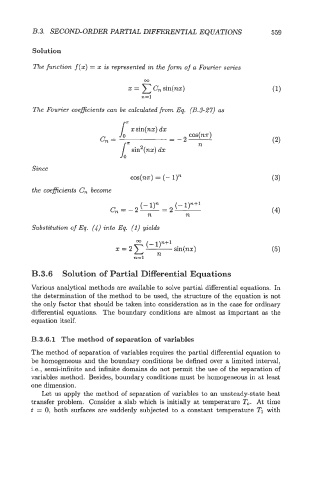Page 579 - Modelling in Transport Phenomena A Conceptual Approach
P. 579
B.3. SECONDORDER PARTIAL, DWFERENTLAL EQUATIONS 559
Solution
The function f (x) = x is represented in the fom of a Fourier series
00
x = C, sin(nx)
n=l
The Fourier coefficients can be calculated from Eq. (3.3-27) as
lT sin(nx) dx
x
Cn= ?r = -2- cos(nn)
n
1 sin2(nx) dx
Since
cos(nn) = (-
the coefficients Cn become
c n- --2-- (- 1)" - (- l)n+l
n n
Substitution of Eq. (4) into Eq. (1) yields
B.3.6 Solution of Partial Differential Equations
Various analytical methods are available to solve partial differential equations. In
the determination of the method to be used, the structure of the equation is not
the only factor that should be taken into consideration as in the case for ordinary
differential equations. The boundary conditions are almost as important as the
equation itself.
B.3.6.1 The method of separation of variables
The method of separation of variables requires the partial differential equation to
be homogeneous and the boundary conditions be defined over a limited interval,
i.e., semi-infinite and infinite domains do not permit the use of the separation of
variables method. Besides, boundary conditions must be homogeneous in at least
one dimension.
Let us apply the method of separation of variables to an unsteady-state heat
transfer problem. Consider a slab which is initially at temperature To. At time
t = 0, both surfaces are suddenly subjected to a constant temperature TI with

